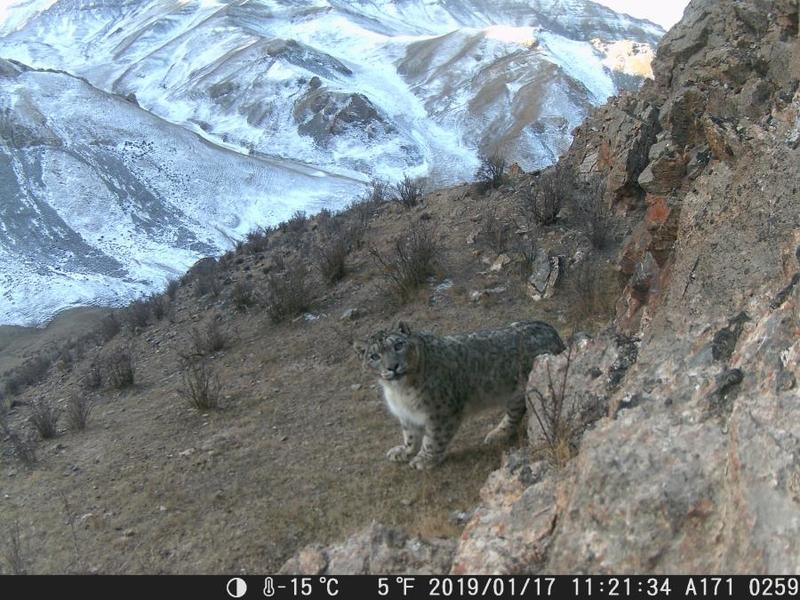 This infrared photo taken on Jan 17, 2019 shows a snow leopard in the Qilian Mountains National Park in Northwest China's Qinghai province. (PHOTO / XINHUA)
This infrared photo taken on Jan 17, 2019 shows a snow leopard in the Qilian Mountains National Park in Northwest China's Qinghai province. (PHOTO / XINHUA)
Photos of snow leopards and Chinese mountain cats sparked a surge in public interest in the two endangered species last week when a deputy from Qinghai province showed them to President Xi Jinping during the annual meeting of China's top legislature.
The two photos shown by Kong Qingju, a National People's Congress deputy from the northwestern province, were taken in the Qilian Mountain National Park in recent years.
Before the establishment of the park in 2017, Qinghai's wildlife had been seriously threatened by overgrazing, overdeveloped tourism, illegal mining and the general degradation of its vegetation dating back to the 1980s, with wildlife populations declining sharply, Kong said.
Thanks to resolute environmental protection efforts from both the government and local people, the Qilian Mountains have been protected under the strictest rules and are now seeing larger green areas, fewer sandstorms and cleaner water.
Kong Qingju, a National People's Congress deputy from Qinghai province
"Thanks to resolute environmental protection efforts from both the government and local people, the Qilian Mountains have been protected under the strictest rules and are now seeing larger green areas, fewer sandstorms and cleaner water," she said.
Qilian Mountain National Park was established as one of the country's 10 pilot national parks. It protects 50,200 square kilometers spanning the border of Qinghai and Gansu provinces, with roughly 15,800 sq km in Qinghai featuring forest, grassland, desert and wetland landscapes.
The ecosystem of the Qilian Mountains has been recovering steadily since the park was established, with the populations of some endangered species rebounding.
ALSO READ: Wild moments
Animals not seen since the 1990s due to excessive hunting have been captured by infrared cameras several times in recent years. They include snow leopards and Chinese mountain cats, both listed as "vulnerable" by the International Union for Conservation of Nature.
"Chinese mountain cats are the most mysterious wild animals and the only confirmed locations in the world are the provinces of Qinghai and Sichuan in China," said Zhang Yu, deputy director of the park's Qinghai management office.
A photo of five Chinese mountain cats that Kong showed to Xi was taken in July during a survey conducted by the management office and researchers from Peking University. It showed a mother cat and her four offspring playing on a mountain.
"For felines that usually give birth to two or three babies at once, such a big family is very rare and precious for the study of this cat," said Gao Yayue, who is in charge of the management office's wildlife observation work.
 This infrared photo taken on July 3, 2020 shows a Chinese desert cat in the Qilian Mountains National Park in Northwest China's Qinghai province. (PHOTO / XINHUA)
This infrared photo taken on July 3, 2020 shows a Chinese desert cat in the Qilian Mountains National Park in Northwest China's Qinghai province. (PHOTO / XINHUA)
The other photo, showing a five-member snow leopard family, was taken in the park's Qinghai section in May 2018.
The snow leopard is a Class A protected animal in China. It is estimated that about 2,000 live in Qinghai, Sichuan and Gansu provinces and the Xinjiang Uygur and Tibet autonomous regions.
READ MORE: Snow leopard numbers rise, but species still at risk
The park management office has been observing its snow leopards since 2017, with more than 1,100 cameras covering 5,000 sq km. They have captured more than 3,000 photos and videos of the rare species.
Apart from the two cats, Kong said the park has seen increasing numbers of other State-protected wild animals in recent years thanks to environmental protection efforts.
In December, seven alpine musk deer, classified as "endangered" on the IUCN's Red List of Threatened Species, were spotted in the park.
In February, a herd of nearly 100 wild red deer under State protection was seen by park rangers.
Zhang said the frequent sightings of wild animals in the park are an indication of an improved environment.
"China has been continuously strengthening wildlife protection efforts in recent years," he said. "Protected regions have seen their ecosystems and biodiversity improved. That's the real action that China has taken to promote a green development path."


